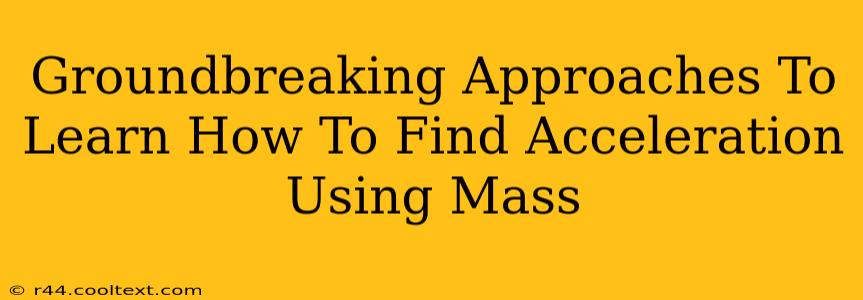Understanding acceleration and its relationship to mass is fundamental in physics. This post explores groundbreaking approaches to mastering the calculation of acceleration, focusing on the crucial role mass plays. We'll move beyond rote memorization and delve into intuitive understanding and practical application.
The Foundation: Newton's Second Law
At the heart of calculating acceleration lies Newton's Second Law of Motion: F = ma, where:
- F represents the net force acting on an object (measured in Newtons).
- m represents the mass of the object (measured in kilograms).
- a represents the acceleration of the object (measured in meters per second squared, m/s²).
This simple equation is the cornerstone of our exploration. Understanding each variable and their interrelationships is key to mastering acceleration calculations.
Solving for Acceleration: A Step-by-Step Guide
To find acceleration (a), we rearrange Newton's Second Law:
a = F/m
This formula tells us that acceleration is directly proportional to the net force and inversely proportional to the mass. Let's break this down:
- Direct Proportionality (Force & Acceleration): If you double the net force acting on an object, its acceleration will also double (assuming mass remains constant).
- Inverse Proportionality (Mass & Acceleration): If you double the mass of an object, its acceleration will be halved (assuming force remains constant).
Beyond the Formula: Intuitive Understanding
Memorizing the formula is only half the battle. Truly grasping the concept requires intuitive understanding. Imagine pushing a shopping cart:
- Pushing with more force (increased F): The cart accelerates faster.
- Pushing a heavier cart (increased m): The cart accelerates slower.
This simple analogy embodies the essence of Newton's Second Law and the relationship between force, mass, and acceleration.
Practical Applications and Examples
Let's solidify our understanding with some examples:
Example 1: A 10 kg object experiences a net force of 50 N. What is its acceleration?
Using the formula: a = F/m = 50 N / 10 kg = 5 m/s²
Example 2: A car with a mass of 1500 kg accelerates at 2 m/s². What is the net force acting on the car?
Rearranging the formula: F = ma = 1500 kg * 2 m/s² = 3000 N
Advanced Concepts and Considerations
While the basic formula provides a solid foundation, real-world scenarios often introduce complexities:
- Friction: Friction opposes motion and reduces acceleration. Calculating acceleration in real-world situations often requires accounting for frictional forces.
- Multiple Forces: Objects are often subjected to multiple forces. To calculate acceleration, you need to determine the net force – the vector sum of all forces acting on the object.
Mastering Acceleration: A Continuous Journey
Learning to calculate acceleration using mass is a journey of understanding, not just memorization. By combining a firm grasp of Newton's Second Law with intuitive understanding and practical application, you'll not only master the calculations but develop a deeper appreciation for the fundamental principles of physics. This allows for a stronger foundation for further physics studies. Keep practicing, and you'll become proficient in solving acceleration problems in various contexts.

